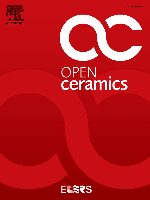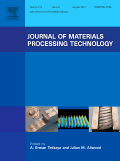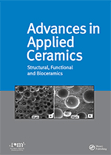
Open Ceramics
Scope & Guideline
Catalyzing Progress in Materials Innovation
Introduction
Aims and Scopes
- Sustainable Ceramics:
The journal promotes research on sustainable materials and processes, including the valorization of waste materials and the development of eco-friendly ceramic products. - Advanced Manufacturing Techniques:
Focus on innovative manufacturing methods such as additive manufacturing (3D printing), cold sintering, and spark plasma sintering to enhance the performance and application scope of ceramics. - Functional and Structural Ceramics:
Research on the development of functional ceramics with specific properties, such as piezoelectric, dielectric, and thermoelectric characteristics, as well as structural ceramics for industrial applications. - Characterization and Modelling:
Emphasis on the characterization of ceramic materials, understanding their microstructure, and modeling their processing and performance to predict behavior under various conditions. - Biomedical Applications:
Exploration of ceramics in biomedical contexts, including bioactive glasses and scaffolds for tissue engineering, emphasizing the need for materials that promote healing and integration with biological systems.
Trending and Emerging
- Digital Processing and Additive Manufacturing:
There is a notable increase in research focusing on digital light processing (DLP) and other 3D printing techniques for ceramics, highlighting the importance of precision manufacturing and customization. - Eco-friendly and Sustainable Materials:
Emerging trends show a growing interest in the development of sustainable ceramics, including those made from recycled materials and waste products, which aligns with global sustainability goals. - Advanced Functional Ceramics:
Research on advanced functional ceramics, such as those with unique electrical, thermal, and mechanical properties, is gaining traction, particularly for applications in electronics and energy storage. - Nanostructured and Composite Materials:
The exploration of nanostructured ceramics and ceramic composites is on the rise, focusing on enhancing material properties and expanding their application range, particularly in high-performance environments. - Biomedical Innovations:
There is an increasing emphasis on the use of ceramics in biomedical applications, particularly in the development of scaffolds for tissue engineering and bioactive materials for medical devices.
Declining or Waning
- Traditional Ceramics:
Research related to traditional ceramic materials and methods, such as historical ceramics and conventional firing techniques, has seen a reduction in focus as the journal shifts towards innovative and advanced materials. - Low-tech Applications:
There appears to be a decline in research focused on low-tech ceramic applications, as the field moves towards high-performance materials for advanced applications, particularly in electronics and energy sectors. - Non-sustainable Practices:
Research that does not align with sustainability principles is becoming less prominent, as the journal increasingly favors eco-friendly and sustainable approaches to ceramic production.
Similar Journals

Advanced Powder Materials
Catalyzing Research in Advanced MaterialsAdvanced Powder Materials, published by KEAI PUBLISHING LTD, stands at the forefront of research in materials science, particularly focusing on the intricate relationships within powder materials and their applications across several domains including catalysis, ceramics, energy, and coatings. With an Open Access policy initiated in 2022, this journal ensures that cutting-edge findings are readily accessible to researchers, professionals, and students globally. Based in Beijing, China, the journal has gained recognition for its exceptional impact, achieving a prestigious Q1 ranking in multiple categories such as Catalysis, Ceramics and Composites, and Materials Science. The journal not only promotes innovative research but also serves as a vital platform for interdisciplinary collaboration, significantly impacting the fields it covers, which also include notable rankings in Metals and Alloys and Surfaces, Coatings, and Films. By fostering an environment of knowledge sharing, Advanced Powder Materials is poised to make substantial contributions to the scientific community over its converged years from 2022 to 2024.

AMERICAN CERAMIC SOCIETY BULLETIN
Shaping the Landscape of Ceramic AdvancementsAMERICAN CERAMIC SOCIETY BULLETIN, published by the American Ceramic Society, serves as a pivotal publication in the field of ceramics and composites, highlighting research and advancements from 1969 to 1990, and resuming from 1993 to 2019, with a focus on the ongoing developments anticipated in 2023 and beyond. With an ISSN of 0002-7812 and an E-ISSN of 1945-2705, this journal stands out in its category, earning a respectable Q2 rank in the 2022 quartile rankings for Materials Science. Although not Open Access, its content remains essential for researchers, professionals, and students dedicated to exploring innovative materials and their applications. The journal's commitment to disseminating quality research fosters an informed community that drives the evolution of ceramics and composites, ensuring its readers stay at the forefront of this dynamic field.

Transactions of the Indian Ceramic Society
Unveiling Insights in Ceramic ScienceTransactions of the Indian Ceramic Society is a distinguished journal published by Taylor & Francis Ltd, focusing on the vital field of ceramics and composites. With an ISSN of 0371-750X and an E-ISSN of 2165-5456, this journal serves as a crucial platform for disseminating cutting-edge research and innovations in ceramic materials science. Operating since 1941, it has established a solid reputation within the academic community, currently holding a Q3 ranking in the Ceramics and Composites category according to the 2023 Scopus rankings. Though not an open-access journal, it provides a wealth of insights and findings that can significantly impact both theoretical and practical applications in materials science. The journal aims to facilitate knowledge exchange among researchers, professionals, and students, thereby pushing the boundaries of what is possible in the world of ceramics. It is a valuable resource for anyone looking to advance their understanding and contribute to this ever-evolving field.

JOURNAL OF THE CERAMIC SOCIETY OF JAPAN
Unveiling the future of materials science and ceramics.Journal of the Ceramic Society of Japan is a prominent peer-reviewed journal dedicated to advancing the field of ceramics and composites. Published by Ceramic Society Japan - Nippon Seramikksu Kyokai, this journal serves as a critical platform for innovative research and development within the realms of materials science and condensed matter physics. Established in 1988, it converges a rich history of contributions and anticipates further advancements through 2024. With an emphasis on interdisciplinary research, the journal ranks in the third quartile in multiple categories, including Ceramics and Composites and Materials Chemistry, promising valuable insights for academics and industry professionals alike. Despite its robust academic standing, the journal currently operates without open access, reflecting the challenges of disseminating specialized research in today's competitive landscape. Whether you are a seasoned researcher or an aspiring student, Journal of the Ceramic Society of Japan offers essential resources that can enhance your understanding and foster innovation in ceramic materials.

International Journal of Applied Ceramic Technology
Driving excellence in applied ceramic research.International Journal of Applied Ceramic Technology, published by WILEY, serves as a key platform for advancing the field of ceramics and composites with a rich focus on innovation and practical applications. With an ISSN of 1546-542X and E-ISSN 1744-7402, this journal has established its presence in multiple disciplines, indicated by its impressive Q3 rankings in Ceramics and Composites, Condensed Matter Physics, Marketing, and Materials Chemistry as of 2023. Covering research from 2004 to 2024, it provides a comprehensive repository of knowledge that aids in the understanding and development of materials. Although it lacks Open Access options, the journal maintains rigorous peer-review standards that ensure high-quality publications for researchers, professionals, and students alike. Given its scopus rankings, including a commendable #61 in Ceramics and Composites, this journal is pivotal for anyone looking to deepen their expertise and engage with the latest advancements in ceramic technology.

JOURNAL OF MATERIALS PROCESSING TECHNOLOGY
Elevating Standards in Materials Processing TechnologyJOURNAL OF MATERIALS PROCESSING TECHNOLOGY, published by ELSEVIER SCIENCE SA, is a premier international journal dedicated to the dissemination of cutting-edge research in the field of materials processing. With an impact factor indicative of its high academic quality, this journal features a diverse range of topics, including ceramics, composites, metals, and manufacturing technologies, thereby inspiring innovations within its community. As a recognized Q1 journal across multiple categories—including Ceramics and Composites, Computer Science Applications, Industrial and Manufacturing Engineering, and Modeling and Simulation— it ranks among the top in its field. The journal's rigorous peer-review process ensures the publication of only the most significant and relevant studies, supporting researchers, professionals, and students in advancing their knowledge and expertise. With its commitment to excellence, the JOURNAL OF MATERIALS PROCESSING TECHNOLOGY remains a vital resource for those aiming to push the boundaries of materials science and engineering.

Journal of the Korean Ceramic Society
Leading the way in ceramic materials research and discovery.The Journal of the Korean Ceramic Society is a premier academic journal dedicated to advancing the field of ceramics and composites, serving as a vital platform for researchers, professionals, and students alike. Published by SPRINGER HEIDELBERG, this journal boasts an impressive scopus rank of #49 out of 127 in the Materials Science category, with a commendable 61st percentile ranking, highlighting its impact and relevance in contemporary research. Since its inception, the journal has been converging significant research contributions from 2007 to 2024, consistently fostering innovation in ceramic materials and their diverse applications. Although it operates under a traditional access model, the journal remains committed to disseminating high-quality research in ceramics and composites, currently positioned in the Q2 category for 2023. With a strategic focus on the latest developments, methodologies, and interdisciplinary approaches, the Journal of the Korean Ceramic Society is essential reading for anyone engaged in materials science and engineering, aiming to navigate the complexities of this dynamic field.

Journal of the Australian Ceramic Society
Advancing the Science of Ceramics and CompositesThe Journal of the Australian Ceramic Society, with ISSN 2510-1560 and E-ISSN 2510-1579, is a distinguished publication by SPRINGER, dedicated to advancing the field of ceramics and composites. Located in Switzerland, this journal serves as a vital platform for researchers, professionals, and students in the realm of materials science, particularly focusing on the innovative applications and developments within ceramics and materials chemistry. Achieving a Q3 quartile ranking in both the Ceramics and Composites and Materials Chemistry categories in 2023, it reflects its commitment to fostering knowledge exchange and intellectual discourse in these critical areas, as evidenced by its Scopus rankings. Spanning from 2007 to 2024, the journal not only supports rigorous peer-reviewed research but also encourages accessibility to cutting-edge findings, making it an essential resource for anyone engaged in ceramic materials research.

Advances in Applied Ceramics
Unlocking the Potential of Ceramics in Modern ApplicationsAdvances in Applied Ceramics is a prestigious journal published by SAGE Publications Inc, specializing in the dynamic fields of ceramics and composites, as well as industrial and manufacturing engineering. Established in 2004 and currently holding a notable Q3 ranking in Ceramics and Composites and a Q2 ranking in Industrial and Manufacturing Engineering, this journal is dedicated to disseminating innovative research and practical applications that advance the understanding and functionality of ceramics within various industries. With an impressive impact factor reflecting its academic influence, Advances in Applied Ceramics serves as a vital resource for researchers, professionals, and students alike, offering insights into cutting-edge developments. Accessible through extensive open access options, the journal ensures the broad dissemination of knowledge, fostering collaboration and engagement in the rapidly evolving realm of material sciences. Set in the heart of the United Kingdom, its contributions are recognized globally, placing it at the forefront of academic discourse in its field.

Journal of Ceramic Science and Technology
Fostering Collaboration in Ceramic ResearchJournal of Ceramic Science and Technology, published by GOLLER VERLAG GMBH in Germany, serves as a vital platform for advancements in the field of ceramics and composites. Since its inception in 2010, the journal has contributed significantly to the scholarly literature, encompassing a wide range of topics including the development of new ceramic materials, nanocomposites, and their various applications in industries such as electronics, energy, and medicine. Although currently categorized in the Q4 quartile of ceramics and composites and ranked within the lower percentile in Scopus, the journal strives to bridge the gap between fundamental research and practical implementation, fostering innovative solutions to contemporary materials challenges. With an open-access format, it ensures that valuable findings are disseminated widely, promoting collaboration and knowledge sharing among researchers, professionals, and students in the field. As it converges towards 2024, the Journal of Ceramic Science and Technology remains committed to enhancing the understanding and utilization of ceramic materials, making it an indispensable resource for those dedicated to advancing this dynamic area of study.